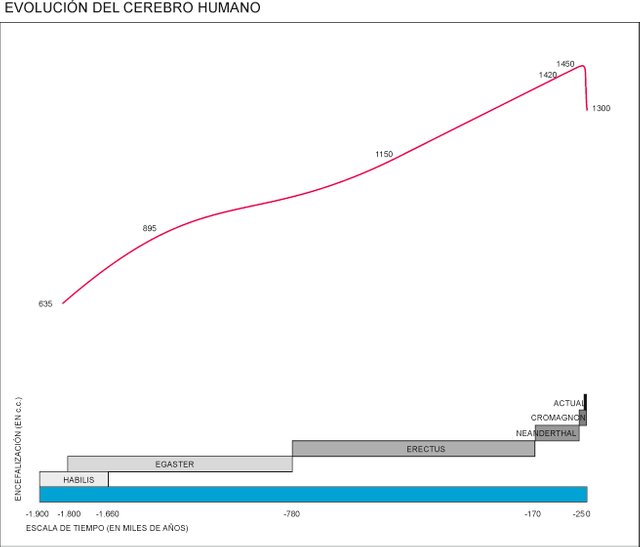The Culture brutalizes

The evolution of the brain through hominids tells us a long history in which some arboreal animals could conquer the soil and compete with animals that outnumbered them, in size, strength and speed. Apart from a great resistance in several days’ race, the hominids had an organ that made the difference: their brain.
And it is evolution that made them human.
The brain is a plastic organ whose functioning is based on the creation of dynamic neuronal networks whose internal chemistry varies at every moment.
There are three large functional units in which we can divide brain work. The vital functions of body control (rūpa), memory, (namā), and processing capacity (citta).
It must be made clear that networks do not involve specific neurons but their networks, in which they can participate.
The hominids, at first, lacked language, so their conceptual world (namā) was very poor, but they needed a lot of processing power to save the life circumstances that were presented to them day by day. They had to be literally inventing everything every day only to survive.
The commitment to increase encephalization in order to increase the functionality of the conscience, resulted in a slow but very continuous evolutionary success, so that, during almost two million years, the different species of hominids were increasing their brain capacity in a way Very uniform at a rate of 100 cc every 100,000 years, approximately.
It must be considered that, in the precultural environment, who failed in their processing capacity, was dead, and their genes did not pass to the next generation. Put another way, fools could not survive long enough to replicate themselves.
The subconscious was giving guidelines to the hominid in order to get sex and food, rewarding him with doses of serotonin and dopamine and punishing him, withdrawing them if the reproductive objective, either in the form of copulas or in the form of accumulation of goods to provide for his offspring, it was not achieved. In this way, the hominids were identifying “good” with “happiness”, although at a very basic level, because if the subconscious failed and rewarded what it should not, the vital continuity of the hominid was compromised. This was how the ability to hit the reward system was fine-tuned. Failures, I repeat, are paid with death and do not pass to the next generation.
From 1.900.000 years ago, with homo habilis, different species of hominids were relieved, improving their encephalization until reaching the maximum between the mixture that occurred between the Neanderthal man and the first Cromagnon, where the maximum development is reached brain about 25,000 years ago.
Neanderthal men were very unsocial, while their successors were very social. At the peak, the largest brain ever recorded by any hominid, rūpa would have remained constant or varying little. The senses evolved to become thinner, but not excessively. And, with a precultural conceptualization, that is, very basic, namā was almost non-existent. Therefore, most of the brain mass was used for pure processing, so the first humans had to be very skilled in spatial thinking, in the ability to intuition and even in mysticism. Great brains dedicated almost exclusively to thinking.
In fact, art was invented by the Neanderthals 68,000 years ago with very significant drawings and schemes.
However, from the introduction of language and civilization, which previously required a powerful neural network to solve in seconds, now a small network was enough to remember what was learned by imitation. It is much easier to learn something, whatever it is, than to invent it if needed.
Evidently, civilization meant an important improvement in the survival of the individual, ensuring their survival despite being mentally deficient since the social networks themselves helped survival, through education or assistance.
Even today education and health of the society grouped in state form are expected. That is, it is not new.
Being much more economical to remember than inventing, the brain began to use process resources (citta) and began using them in conceptualization resources (namā), so that a large amount of metabolic resources could be saved simply by using memory in place of creative thinking.
Organ that is not used, organ that atrophies. And much more even if that organ consumes nothing less than 20% of the entire basal metabolism. The principle of energy economy will mean that every time you use less and only the essential will be used. And the time will come when he will not consume even the minimum that the rest of the body produces for him. And yes, we are talking about the brain.
The neurologist Marcus E. Raichle published in Science in 2006 an article called “The Dark Energy of the Brain”. In which gives some data so we have an idea of the magnitude of the matter. The brain represents approximately 2% of the weight of the human body. However, it consumes 20% of the energy of the human organism. That, in itself, is striking. What the hell do you need so very?
The answer is fascinating: to do NOTHING, well, keep knowing who you are.
To understand it, we must consider that to remain who you are means to maintain the ego and the whole memetic system, learned by imitation and that makes up a good part of what is namā. You have to understand that even though brain chemistry changes constantly, you still know what you know.
Raichle calculated that this “maintenance mode” or “default mode” consumes nothing less than 95% of that energy and maintains a series of networks that have nothing to do with external stimuli or processing.
Since neurons can only process energy from glucose, not from other sugars or lipids, the brain uses it as fuel with an approximate consumption of 5.6mg of glucose per 100g of brain tissue per minute, that represents more than 105 grams of pure glucose a day. Of which, 96 grams are used to maintain its maintenance network.
This basic network is involved in processes such as Alzheimer’s, where the individual loses the notion of himself. Doing “nothing”, just remembering, is vital and consumes a lot of resources.
That is, the current human brain only has 5% for external processes that involve the senses and the motor apparatus and for consciousness. In other words, practically nothing remains to process.
The modern human brain is functionally staying in the basics: remember who it is, what it knows and where it is. That is, the energy needed to maintain the machine of the memes. And since less and less process capacity is needed thanks to conceptualization, you do not need as much brain that consumes so much. In this way we can contemplate the disaster that culture has caused in the history of the homo genre.
In the following graph we can observe in red the curve of encephalization measured in terms of cranial capacity. As the brain does not fossilize, we must induce objective data such as this capacity with respect to body weight to induce encephalization.
The ordinates are in cubic centimeters while the abscissas represent the time line in thousands of years beginning in -1,900,000 years and ending at present.

The different species of the genus homo, are happening increasing linearly and progressively that capacity, starting with the Habilis, continuing with the Egaster, the Erectus and culminating with the Neanderthal and the first individuals of our species, the Cromagnon.
And here we see what in an economic graph we could see as the puncture of the encephalization bubble: in the last 10,000 years (only 0.5% of the time studied) has precipitated abruptly no less than 15% and with tendency to go to worse.
As we have seen, what has happened to homo sapiens sapiens over these 10,000 years has been Culture.
Culture has charged man as an intelligent animal with the ability to think and create and is turning it into a machine for storing memes, leaving no room for superior mental capacities.
A brain increasingly smaller and crammed with garbage has returned us to homo Erectus levels. And, functionally, the vast majority of “current” humans are not different from Erectus.
Culture is killing the brain and the welfare society has enhanced the survival of the imbeciles, preventing them not only from dying, which would be the evolutionarily expected, but it has enhanced them in a miserable way.
And the future is seen with a negative perspective very quickly.
The irruption of new technologies has on the one hand a massive bombardment of information in deficient brains incapable of processing it, only trying to accumulate it, converting these supposed humans into simple meme replicating machines, in environments of low mental productivity and leading to human species towards the Society of Imbecilización of irreversible form.
That it is humans who can be enlightened, we know, as we know that animals can not achieve it.
And something very important that must be made very clear: the bad guys can become enlightened, the fools can not. There we have two emblematic examples with the serial killer Angulimala who had a souvenir necklace with the fingers of his victims, who arrived at the arahantado, and the good, tender but silly one of Ānanda, the Buddha’s assistant. that he did not succeed.
Recall that the Gotama Buddha was illiterate, which greatly favored his achievement.
Enlighten today with the amount of conceptualization in which we are immersed (concepts are ignorance) is something really out of the ordinary. In addition, with the loss of the same human condition of the people. This loss, in a generic way, we have collected in the Sutta del Linea tells us that the arahants produced by each Buddha have been in progressive decline:
Vipassi 100,000
Sikhī 70,000
Vessabhū 60,000
Kakusandha 40,000
Konāgamana 30,000
Kassapa 20,000
Gotama 1.230
We should not expect more than 75 arahants in the eighth, and last, when the window of opportunity of Nibbana will remain open.
The rest is already known, conditionality tends to the highest level of disorder and everything we see, experience and contemplate, as conditions that are, will end in the Padana, the last hell.
Things of entropy in closed systems.
The conditions are set and they are passing you over.
The goal of education is to make the individual have more knowledge, more skills not to be more intelligent, not to know how to think more and better. It is always easier to give a recipe than to make the person capable of making it by itself. And if there is no adaptive survival pressure, the brain becomes the machine of memes, unable to think, to elaborate but only to imitate, memorize, try to marry situations and repeat. The most evolved organ on the face of the Earth become a copy and paste clipboard. And the bug that carries it alone knows how to look at what makes it happy or unhappy to be able to discern the convenience of the inconvenient.
The culture brutalizes.
nice post @tomasmorales
Resteemed by @resteembot! Good Luck!
The resteem was paid by @greetbot
Curious? Read @resteembot's introduction post
Check out the great posts I already resteemed.
ResteemBot's Maker is Looking for Work.
Hi. I am a bot that looks for newbies who write good content!
Your post passed all of my tests.
You get:
I also write bots and other code for crypto....